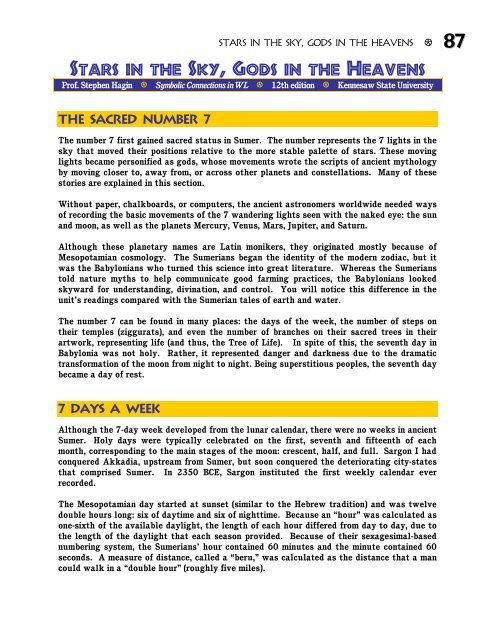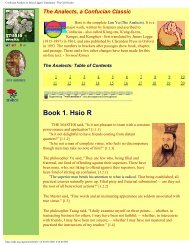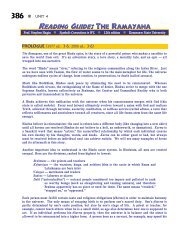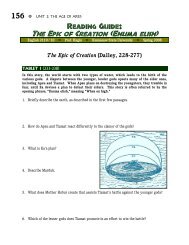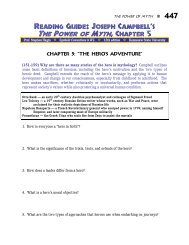Stars in the Sky, Gods in the Heavens - KsuWeb - Kennesaw State ...
Stars in the Sky, Gods in the Heavens - KsuWeb - Kennesaw State ...
Stars in the Sky, Gods in the Heavens - KsuWeb - Kennesaw State ...
Create successful ePaper yourself
Turn your PDF publications into a flip-book with our unique Google optimized e-Paper software.
<strong>Stars</strong> <strong>in</strong> <strong>the</strong> <strong>Sky</strong>, <strong>Gods</strong> <strong>in</strong> <strong>the</strong> heavens K 87<br />
<strong>Stars</strong> <strong>in</strong> <strong>the</strong> <strong>Sky</strong>, <strong>Gods</strong> <strong>in</strong> <strong>the</strong> <strong>Heavens</strong><br />
Prof. Stephen Hag<strong>in</strong> K Symbolic Connections <strong>in</strong> WL K 12th edition K <strong>Kennesaw</strong> <strong>State</strong> University<br />
The Sacred Number 7<br />
The number 7 first ga<strong>in</strong>ed sacred status <strong>in</strong> Sumer. The number represents <strong>the</strong> 7 lights <strong>in</strong> <strong>the</strong><br />
sky that moved <strong>the</strong>ir positions relative to <strong>the</strong> more stable palette of stars. These mov<strong>in</strong>g<br />
lights became personified as gods, whose movements wrote <strong>the</strong> scripts of ancient mythology<br />
by mov<strong>in</strong>g closer to, away from, or across o<strong>the</strong>r planets and constellations. Many of <strong>the</strong>se<br />
stories are expla<strong>in</strong>ed <strong>in</strong> this section.<br />
Without paper, chalkboards, or computers, <strong>the</strong> ancient astronomers worldwide needed ways<br />
of record<strong>in</strong>g <strong>the</strong> basic movements of <strong>the</strong> 7 wander<strong>in</strong>g lights seen with <strong>the</strong> naked eye: <strong>the</strong> sun<br />
and moon, as well as <strong>the</strong> planets Mercury, Venus, Mars, Jupiter, and Saturn.<br />
Although <strong>the</strong>se planetary names are Lat<strong>in</strong> monikers, <strong>the</strong>y orig<strong>in</strong>ated mostly because of<br />
Mesopotamian cosmology. The Sumerians began <strong>the</strong> identity of <strong>the</strong> modern zodiac, but it<br />
was <strong>the</strong> Babylonians who turned this science <strong>in</strong>to great literature. Whereas <strong>the</strong> Sumerians<br />
told nature myths to help communicate good farm<strong>in</strong>g practices, <strong>the</strong> Babylonians looked<br />
skyward for understand<strong>in</strong>g, div<strong>in</strong>ation, and control. You will notice this difference <strong>in</strong> <strong>the</strong><br />
unit’s read<strong>in</strong>gs compared with <strong>the</strong> Sumerian tales of earth and water.<br />
The number 7 can be found <strong>in</strong> many places: <strong>the</strong> days of <strong>the</strong> week, <strong>the</strong> number of steps on<br />
<strong>the</strong>ir temples (ziggurats), and even <strong>the</strong> number of branches on <strong>the</strong>ir sacred trees <strong>in</strong> <strong>the</strong>ir<br />
artwork, represent<strong>in</strong>g life (and thus, <strong>the</strong> Tree of Life). In spite of this, <strong>the</strong> seventh day <strong>in</strong><br />
Babylonia was not holy. Ra<strong>the</strong>r, it represented danger and darkness due to <strong>the</strong> dramatic<br />
transformation of <strong>the</strong> moon from night to night. Be<strong>in</strong>g superstitious peoples, <strong>the</strong> seventh day<br />
became a day of rest.<br />
7 Days a Week<br />
Although <strong>the</strong> 7-day week developed from <strong>the</strong> lunar calendar, <strong>the</strong>re were no weeks <strong>in</strong> ancient<br />
Sumer. Holy days were typically celebrated on <strong>the</strong> first, seventh and fifteenth of each<br />
month, correspond<strong>in</strong>g to <strong>the</strong> ma<strong>in</strong> stages of <strong>the</strong> moon: crescent, half, and full. Sargon I had<br />
conquered Akkadia, upstream from Sumer, but soon conquered <strong>the</strong> deteriorat<strong>in</strong>g city-states<br />
that comprised Sumer. In 2350 BCE, Sargon <strong>in</strong>stituted <strong>the</strong> first weekly calendar ever<br />
recorded.<br />
The Mesopotamian day started at sunset (similar to <strong>the</strong> Hebrew tradition) and was twelve<br />
double hours long: six of daytime and six of nighttime. Because an “hour” was calculated as<br />
one-sixth of <strong>the</strong> available daylight, <strong>the</strong> length of each hour differed from day to day, due to<br />
<strong>the</strong> length of <strong>the</strong> daylight that each season provided. Because of <strong>the</strong>ir sexagesimal-based<br />
number<strong>in</strong>g system, <strong>the</strong> Sumerians’ hour conta<strong>in</strong>ed 60 m<strong>in</strong>utes and <strong>the</strong> m<strong>in</strong>ute conta<strong>in</strong>ed 60<br />
seconds. A measure of distance, called a “beru,” was calculated as <strong>the</strong> distance that a man<br />
could walk <strong>in</strong> a “double hour” (roughly five miles).
88 K Unit 2<br />
The Sumerian year was divided <strong>in</strong>to twelve lunar months, each be<strong>in</strong>g 29 or 30 days long, and<br />
beg<strong>in</strong>n<strong>in</strong>g at <strong>the</strong> first sight<strong>in</strong>g of <strong>the</strong> new moon. To keep <strong>the</strong> lunar year (354 days) <strong>in</strong> step<br />
with <strong>the</strong> solar year, <strong>the</strong> k<strong>in</strong>g would periodically add an extra month at his decree. This<br />
resulted <strong>in</strong> some years hav<strong>in</strong>g thirteen months <strong>in</strong>stead of <strong>the</strong> normal twelve.<br />
All this was governed by <strong>the</strong> mov<strong>in</strong>g lights <strong>in</strong> <strong>the</strong> sky, so it was deemed. The word “planet”<br />
is derived from <strong>the</strong> Greek “planets,” mean<strong>in</strong>g “wanderers.” The wander<strong>in</strong>gs of <strong>the</strong> planets<br />
will <strong>in</strong>spire much of this unit’s literature, and you will see <strong>the</strong> names of <strong>the</strong> ma<strong>in</strong> characters<br />
immortalized <strong>in</strong> <strong>the</strong> 7 days of <strong>the</strong> week:<br />
Glyph “Star” Sumerian Babylonian Greek Roman<br />
Sun Utu Shamash Helios Sol<br />
Moon Nanna, Suen S<strong>in</strong> Selenê Luna<br />
Mercury N<strong>in</strong>gishzida Nabu Hermes Mercurius<br />
Venus Inanna Ishtar Aphrodite Venus<br />
Mars Gugalanna Nergal Ares Mars<br />
Jupiter Enlil Marduk Zeus Jupiter<br />
Saturn N<strong>in</strong>urta N<strong>in</strong>urta Kronos Saturnus<br />
English Italian French Spanish “Star” Glyph Element<br />
Sunday Domenica Dimanche Dom<strong>in</strong>go Sun gold (Au)<br />
Monday lunedì lundi lunes Moon silver (Ag)<br />
Tuesday martedì mardi martes Mars iron (Fe)<br />
Wednesday mercoledì mercredi miércoles Mercury mercury (Hg)<br />
Thursday giovedì jeudi jueves Jupiter t<strong>in</strong> (Sn)<br />
Friday venerdì vendredi viernes Venus copper (Cu)<br />
Saturday sabato samedi sábado Saturn lead (Pb)<br />
Nomenclature: Days of <strong>the</strong> Week<br />
Our current names <strong>in</strong> English for <strong>the</strong> seven days of <strong>the</strong> week orig<strong>in</strong>ate from two different<br />
sources: astronomical references and Norse mythology: Sunday = The Sun’s Day; Monday =<br />
The Moon’s Day; Saturday = Saturn’s Day. Here are <strong>the</strong> Norse/Germanic identities:<br />
Wednesday = Woden’s Day Woden (or Od<strong>in</strong>) was <strong>the</strong> god of wisdom, war, battle, and death<br />
Friday = Freya’s/Frigg’s Day Freya was <strong>the</strong> goddess of love, sex, war, beauty, and fertility<br />
Tuesday = Tiw’s/Tyr’s Day Tyr was <strong>the</strong> Norse god of combat and heroes<br />
Thursday = Thor’s Day Thor was <strong>the</strong> thunder god who used his hammer to create thunder
The <strong>Sky</strong><br />
Sumer —<br />
Babylonia —<br />
O<strong>the</strong>r Mesop. —<br />
An<br />
Anu<br />
Uru-Anna<br />
<strong>Stars</strong> <strong>in</strong> <strong>the</strong> <strong>Sky</strong>, <strong>Gods</strong> <strong>in</strong> <strong>the</strong> heavens K 89<br />
Egypt —<br />
Greece —<br />
Rome —<br />
Nut<br />
Uranus<br />
Uranus<br />
The Mesopotamian sky was divided <strong>in</strong>to three realms: <strong>the</strong> “way of Anu” was <strong>the</strong> vertical<br />
band ris<strong>in</strong>g from <strong>the</strong> eastern horizon, provid<strong>in</strong>g a pathway for <strong>the</strong> sun and <strong>the</strong> Milky Way to<br />
follow. Flanked to ei<strong>the</strong>r side were two o<strong>the</strong>r realms: <strong>the</strong> “Way of Enlil” resided <strong>in</strong> <strong>the</strong><br />
north, from where favorable w<strong>in</strong>ds from Enlil blew <strong>in</strong> <strong>the</strong> ra<strong>in</strong> and perhaps were attributed<br />
to <strong>the</strong> motion of <strong>the</strong> seven mov<strong>in</strong>g lights. The “Way of Enki” fell to <strong>the</strong> south, where Enki<br />
presided over <strong>the</strong> “fixed stars,” or <strong>the</strong> constellations of <strong>the</strong> zodiac. The sou<strong>the</strong>rn horizon<br />
also received <strong>the</strong> waters flow<strong>in</strong>g <strong>in</strong> a sou<strong>the</strong>rly direction <strong>in</strong>to <strong>the</strong> Persian Gulf. The land,<br />
<strong>the</strong> “sphere of elements,” was governed by Ki, an early form of <strong>the</strong> birth mo<strong>the</strong>r N<strong>in</strong>hursag<br />
(also called N<strong>in</strong>mah, Aruru, etc.).<br />
In Greek mythology, Uranus was considered to be <strong>the</strong> earliest god of <strong>the</strong> heavens, <strong>the</strong> son of<br />
Terra (or Gaea), <strong>the</strong> earth. Uranus married his mo<strong>the</strong>r and became <strong>the</strong> chief lord until his<br />
son Saturn (Kronos) deposed him (and was later deposed by his son Jupiter (Zeus).<br />
The Sun<br />
Sumer —<br />
Babylonia —<br />
O<strong>the</strong>r Mesop. —<br />
Utu<br />
Shamash<br />
Bishebi, Shash-aru<br />
Egypt —<br />
Greece —<br />
Rome —<br />
Ra<br />
Helios<br />
Sol<br />
The sun represents power, justice, omniscience, and compassion <strong>in</strong> most mythologies. In<br />
Mesopotamia, Utu (Shamash) provides direct assistance to many literary characters, perhaps<br />
representations of <strong>the</strong> o<strong>the</strong>r planets. Shamash was said to create sunbeams with his saw<br />
that he used to cut his way through <strong>the</strong> Zagros Mounta<strong>in</strong>s to <strong>the</strong> east each sunrise, pa<strong>in</strong>t<strong>in</strong>g<br />
him as a character of great power and virility. The Egyptian sun god Ra would also acquire<br />
<strong>the</strong> personality of a strong and aggressive god, rul<strong>in</strong>g <strong>the</strong> sky.<br />
In Greek mythology, <strong>the</strong> Titan Hyperion was <strong>the</strong> orig<strong>in</strong>al sun god, but he was ultimately<br />
replaced by his son Helios (Sol), <strong>the</strong> “royal sun” who looked over his cattle <strong>in</strong> The Odyssey.<br />
The Moon<br />
Sumer —<br />
Babylonia —<br />
O<strong>the</strong>r Mesop. —<br />
Nanna, Suen<br />
S<strong>in</strong><br />
Aku<br />
Egypt —<br />
Greece —<br />
Rome —<br />
Khons, Thoth<br />
Selene/Artemis<br />
Luna/Diana<br />
Nanna (also Suen or S<strong>in</strong>) was called “<strong>the</strong> wise lord” or <strong>the</strong> “Lord of Wisdom” by <strong>the</strong><br />
Babylonians, who perhaps acknowledged <strong>the</strong> art of calendar mak<strong>in</strong>g by track<strong>in</strong>g <strong>the</strong> moon’s
90 K Unit 2<br />
changes each night. Technically, “Nanna” refers to <strong>the</strong> full moon, while Suen (S<strong>in</strong>) refers to<br />
<strong>the</strong> new moon. Nanna was fa<strong>the</strong>r to both Utu (<strong>the</strong> sun) and Ishtar (Venus), suggest<strong>in</strong>g his<br />
importance to <strong>the</strong> Sumerian pan<strong>the</strong>on.<br />
The moon’s wax<strong>in</strong>g and wan<strong>in</strong>g were often associated with female menstrual cycle and<br />
capricious behavior, but <strong>the</strong> earliest characterizations of <strong>the</strong> moon god were male. The<br />
crescent moon was associated with <strong>the</strong> horns of a bull, creat<strong>in</strong>g <strong>the</strong> most recognizable<br />
fertility symbol from <strong>the</strong> Age of Taurus. The moon’s mutability also caused it to be<br />
associated both with <strong>the</strong> dead, <strong>the</strong> underworld, and immortality. Monthly agricultural<br />
sacrifices were performed to encourage its resurrection on <strong>the</strong> third day of <strong>the</strong> new moon.<br />
In Greek mythology, <strong>the</strong> Titan Atlas and his consort Phoebe ruled <strong>the</strong> moon, ultimately<br />
replaced by <strong>the</strong> goddesses Selene (Luna), Artemis (Diana), and Hekate (Hecate).<br />
Mercury<br />
Sumer —<br />
Babylonia —<br />
O<strong>the</strong>r Mesop. —<br />
N<strong>in</strong>gishzida, Enki<br />
Nabu (Nebo)<br />
Nabul, Bibbu, Lubat-gud<br />
Egypt —<br />
Greece —<br />
Rome —<br />
Anubis, Thoth<br />
Hermes, Apollo<br />
Mercurius<br />
The planet Mercury is <strong>the</strong> fastest <strong>in</strong> our solar system, so most mythologies equate <strong>the</strong> swift<br />
movements of Mercury with a messenger god or a wander<strong>in</strong>g spirit. Some Sumerian cities<br />
assigned N<strong>in</strong>gishzida to <strong>the</strong> speedy planet, call<strong>in</strong>g him <strong>the</strong> “Bull of Light” or “Sh<strong>in</strong><strong>in</strong>g Bull,”<br />
likely communicat<strong>in</strong>g Mercury’s proximity to both <strong>the</strong> sun and <strong>the</strong> constellation Taurus <strong>in</strong><br />
<strong>the</strong> eastern sky <strong>in</strong> spr<strong>in</strong>g and autumn. N<strong>in</strong>gishzida’s descent <strong>in</strong>to <strong>the</strong> underworld and ascent<br />
<strong>in</strong>to <strong>the</strong> Way of Anu is <strong>the</strong> subject of several Sumerian myths. He earned <strong>the</strong> nicknames<br />
“The Buyer-God” and “The Messenger” (Mushtaddullu) due to his ability to transcend <strong>the</strong><br />
realms of <strong>the</strong> underworld and <strong>the</strong> heavens, mak<strong>in</strong>g him a powerful god.<br />
He is also associated with ano<strong>the</strong>r god half-way around <strong>the</strong> world: <strong>the</strong> Aztec creator god<br />
Quetzalcoatl, <strong>the</strong> fea<strong>the</strong>red serpent, who brought civilization to <strong>the</strong> Aztecs and returned to<br />
his heavenly home on a raft of snakes over <strong>the</strong> ocean (and will one day return). O<strong>the</strong>r cult<br />
centers worshipped Enki (N<strong>in</strong>gishzida’s fa<strong>the</strong>r) as Mercury, perhaps due to Enki’s shifty use<br />
of language.<br />
The Babylonians changed Mercury’s god to Nabu, called “The Herald” or “The Prophet,” and<br />
often depicted rid<strong>in</strong>g a mušhuššu dragon on <strong>the</strong> water (same as Marduk, Nabu’s fa<strong>the</strong>r). He<br />
is told to have received prophecies by s<strong>in</strong>g<strong>in</strong>g and chant<strong>in</strong>g <strong>in</strong> foreign tongues. In one story,<br />
Nabu heroically traveled to <strong>the</strong> mounta<strong>in</strong>s and <strong>in</strong>to <strong>the</strong> Underworld to rescue his fa<strong>the</strong>r<br />
Marduk. He was <strong>the</strong> god of writ<strong>in</strong>g, record-keep<strong>in</strong>g, and wisdom, develop<strong>in</strong>g a parallel to<br />
both Enki (his grandfa<strong>the</strong>r and <strong>the</strong> god of wisdom) and <strong>the</strong> Egyptian god Thoth (writ<strong>in</strong>g and<br />
wisdom), even though Thoth was also regarded as a moon god. No Sumerian stories of Nabu<br />
seem to exist.<br />
Nabu even makes his way <strong>in</strong>to <strong>the</strong> Bible: “The Idols of Babylon, Bel [Marduk] and Nebo<br />
[Nabu], are be<strong>in</strong>g hauled away on ox carts! But look! The beasts are stumbl<strong>in</strong>g! The cart is<br />
turn<strong>in</strong>g over! The gods are fall<strong>in</strong>g out onto <strong>the</strong> ground! Is that <strong>the</strong> best <strong>the</strong>y can do? If
<strong>Stars</strong> <strong>in</strong> <strong>the</strong> <strong>Sky</strong>, <strong>Gods</strong> <strong>in</strong> <strong>the</strong> heavens K 91<br />
<strong>the</strong>y cannot even save <strong>the</strong>mselves from such a fall, how can <strong>the</strong>y save <strong>the</strong>ir worshippers<br />
from Cyrus?” (Isaiah 46:1-2)<br />
Greek mythology adapted <strong>the</strong> messenger symbolism with its parallel character Hermes<br />
(Lat<strong>in</strong> Mercurius), <strong>the</strong> a son of Zeus (Jupiter). Hermes means “He of <strong>the</strong> Market” or “The<br />
Retailer”; likewise, Mercurius means “God of Merchandise.” Orig<strong>in</strong>ally, <strong>the</strong> Titan Coeus and<br />
Titaness Metis ruled over Mercury.<br />
Venus<br />
Sumer —<br />
Babylonia —<br />
O<strong>the</strong>r Mesop. —<br />
Inanna<br />
Ishtar<br />
Zib (Zig), Dil-bat<br />
Egypt —<br />
Greece —<br />
Rome —<br />
Hathor<br />
Aphrodite<br />
Venus<br />
Venus bobs up and down <strong>in</strong> both <strong>the</strong> morn<strong>in</strong>g sky as well as <strong>the</strong> even<strong>in</strong>g sky dur<strong>in</strong>g different<br />
times of its 584-day cycle. After resid<strong>in</strong>g <strong>in</strong> <strong>the</strong> western even<strong>in</strong>g horizon for n<strong>in</strong>e months,<br />
Venus rises above <strong>the</strong> sun as it moves <strong>in</strong>to <strong>the</strong> morn<strong>in</strong>g sky for <strong>the</strong> next n<strong>in</strong>e months. After<br />
its <strong>in</strong>itial appearance <strong>in</strong> <strong>the</strong> morn<strong>in</strong>g sky, it <strong>the</strong>n pauses for a bit and slowly follows <strong>the</strong> sun<br />
with each pass<strong>in</strong>g day. It <strong>the</strong>n passes beh<strong>in</strong>d <strong>the</strong> sun, disappears for several weeks, and <strong>the</strong>n<br />
aga<strong>in</strong> moves <strong>in</strong>to <strong>the</strong> even<strong>in</strong>g sky. Venus climbs high <strong>in</strong>to <strong>the</strong> even<strong>in</strong>g sky as is follows <strong>the</strong><br />
Sun to <strong>the</strong> horizon each night. After hang<strong>in</strong>g above <strong>the</strong> sun for a while, Venus plunges back<br />
<strong>in</strong>to <strong>the</strong> morn<strong>in</strong>g sky, and <strong>the</strong> cycle cont<strong>in</strong>ues.<br />
Venus and <strong>the</strong> sun perform this dance about five times <strong>in</strong> eight years. About every 120<br />
years, Venus passes <strong>in</strong> front of <strong>the</strong> sun (this is called a transit). This last occurred on 8 June<br />
2004, when Venus emerged back <strong>in</strong>to <strong>the</strong> morn<strong>in</strong>g sky after glow<strong>in</strong>g as <strong>the</strong> even<strong>in</strong>g star for<br />
<strong>the</strong> previous three seasons. The follow<strong>in</strong>g table shows when Venus will occupy <strong>the</strong> eastern<br />
morn<strong>in</strong>g sky or <strong>the</strong> western even<strong>in</strong>g sky <strong>in</strong> <strong>the</strong> com<strong>in</strong>g years:<br />
Date 2008 2009 2010 2011 2012 2013<br />
Jan 1 morn<strong>in</strong>g even<strong>in</strong>g NV* morn<strong>in</strong>g even<strong>in</strong>g morn<strong>in</strong>g<br />
Feb 1 morn<strong>in</strong>g even<strong>in</strong>g NV* morn<strong>in</strong>g even<strong>in</strong>g morn<strong>in</strong>g<br />
Mar 1 morn<strong>in</strong>g even<strong>in</strong>g even<strong>in</strong>g morn<strong>in</strong>g even<strong>in</strong>g NV*<br />
Apr 1 morn<strong>in</strong>g even<strong>in</strong>g even<strong>in</strong>g morn<strong>in</strong>g even<strong>in</strong>g NV*<br />
May 1 morn<strong>in</strong>g morn<strong>in</strong>g even<strong>in</strong>g morn<strong>in</strong>g even<strong>in</strong>g NV*<br />
Jun 1 NV* morn<strong>in</strong>g even<strong>in</strong>g morn<strong>in</strong>g even<strong>in</strong>g even<strong>in</strong>g<br />
Jul 1 NV* morn<strong>in</strong>g even<strong>in</strong>g morn<strong>in</strong>g morn<strong>in</strong>g even<strong>in</strong>g<br />
Aug 1 even<strong>in</strong>g morn<strong>in</strong>g even<strong>in</strong>g NV* morn<strong>in</strong>g even<strong>in</strong>g<br />
Sep 1 even<strong>in</strong>g morn<strong>in</strong>g even<strong>in</strong>g NV* morn<strong>in</strong>g even<strong>in</strong>g<br />
Oct 1 even<strong>in</strong>g morn<strong>in</strong>g even<strong>in</strong>g even<strong>in</strong>g morn<strong>in</strong>g even<strong>in</strong>g<br />
Nov 1 even<strong>in</strong>g morn<strong>in</strong>g morn<strong>in</strong>g even<strong>in</strong>g morn<strong>in</strong>g even<strong>in</strong>g<br />
Dec 1 even<strong>in</strong>g morn<strong>in</strong>g morn<strong>in</strong>g even<strong>in</strong>g morn<strong>in</strong>g even<strong>in</strong>g<br />
NV — Venus is not visible (too close to <strong>the</strong> sun or <strong>the</strong> sky is too bright)<br />
even<strong>in</strong>g — Venus is visible <strong>in</strong> <strong>the</strong> even<strong>in</strong>g just after dusk<br />
morn<strong>in</strong>g — Venus is visible <strong>in</strong> <strong>the</strong> morn<strong>in</strong>g just before dawn
92 K Unit 2<br />
In Sumer, Venus was known as Inanna, and she was sometimes called S<strong>in</strong>ishat (“The<br />
Female”) or Dil-bat (“The Herald”) because she would rema<strong>in</strong> as <strong>the</strong> brightest light <strong>in</strong> <strong>the</strong><br />
eastern sky before sunrise, beckon<strong>in</strong>g <strong>the</strong> Utu to rise from <strong>the</strong> dark Underworld.<br />
The earliest tablet known to chart star patterns came from <strong>the</strong> court of K<strong>in</strong>g Amisaduqa of<br />
Babylon, dat<strong>in</strong>g between 1646 and 1626 BCE, called The Venus Tablet of Amisaduqa. Here<br />
is a passage from that tablet regard<strong>in</strong>g Venus: “In month XI, 15th day, Venus disappeared <strong>in</strong><br />
<strong>the</strong> west. Three days it stayed away, <strong>the</strong>n on <strong>the</strong> 18th day it became visible <strong>in</strong> <strong>the</strong> east.<br />
Spr<strong>in</strong>gs will open and Adad will br<strong>in</strong>g his ra<strong>in</strong> and Ea his floods. Messages of reconciliation<br />
will be sent from K<strong>in</strong>g to K<strong>in</strong>g.”<br />
The Babylonians called her Ishtar; sometimes she was also referred to as Ilat Shimetan<br />
(“Goddess of <strong>the</strong> Even<strong>in</strong>g Star”) or as “Qadishtu Ilani (“The Pretty Lady of <strong>the</strong> <strong>Gods</strong>”).<br />
Because Venus resides <strong>in</strong> both <strong>the</strong> eastern sky at sunrise and <strong>in</strong> <strong>the</strong> even<strong>in</strong>g sky at sunset,<br />
she has acquired a dual identity <strong>in</strong> Mesopotamian literature.<br />
In <strong>the</strong> even<strong>in</strong>g, she epitomized love, desire, beauty, compassion, and extreme fem<strong>in</strong><strong>in</strong>ity. At<br />
sunset she was called Ishtar of Uruk and “The Lady of <strong>the</strong> <strong>Gods</strong>” as she descended beyond<br />
<strong>the</strong> western horizon with many different characters of <strong>the</strong> zodiac. Because of her perpetual<br />
descent <strong>in</strong>to <strong>the</strong> Underworld, she also acquired status as a goddess of mourn<strong>in</strong>g. After<br />
disappear<strong>in</strong>g for three nights, she is reborn <strong>in</strong> <strong>the</strong> fiery eastern sky at sunrise. Here, she<br />
assumes more aggressive and mascul<strong>in</strong>e characteristics. Now promot<strong>in</strong>g war and authority,<br />
Venus was sometimes called Ishtar of Agade or “Ishtar of <strong>the</strong> <strong>Stars</strong>.”<br />
Her two ma<strong>in</strong> symbols, <strong>the</strong> eight-petaled rosette and <strong>the</strong> lion, also reveal her dual nature.<br />
When associated <strong>in</strong> conjunction with Mercury, Venus often depicted bisexuality (<strong>the</strong> word<br />
“hermaphrodite” comes from comb<strong>in</strong><strong>in</strong>g <strong>the</strong> Greek gods Hermes [Mercury] and Aphrodite<br />
[Venus]). In Egypt, <strong>the</strong> goddess Hathor would parallel Inanna’s/Ishtar’s attributes of both<br />
love and war.<br />
In Greek mythology, Aphrodite was <strong>the</strong> goddess of love who appeared out of <strong>the</strong> sea, born<br />
from <strong>the</strong> severed genitals of her fa<strong>the</strong>r Uranus. The name “Aphrodite” literally means “Born<br />
from Foam.” Orig<strong>in</strong>ally, Venus was a representation of <strong>the</strong> Titan Oceanus and his wife<br />
Tethys.<br />
Mars<br />
Sumer —<br />
Babylonia —<br />
O<strong>the</strong>r Mesop. —<br />
Gugalanna, Nergal<br />
Nergal, Marduk<br />
Zal-bad-anu, Mushtabarru<br />
Egypt —<br />
Greece —<br />
Rome —<br />
Horus<br />
Ares/Herakles<br />
Mars/Hercules<br />
In Sumer, Mars was identified with two Underworld gods who were attributed to be <strong>the</strong><br />
husbands of Ereshkigal, <strong>the</strong> Queen of <strong>the</strong> Underworld. One was Gugalanna, <strong>the</strong> first<br />
Husband of Ereshkigal, also known as <strong>the</strong> “Great Bull of Heaven.” Many stories depict <strong>the</strong><br />
death of Gugalanna, <strong>in</strong>clud<strong>in</strong>g <strong>the</strong> Sumerian story The Descent of Inanna and <strong>the</strong> Akkadian<br />
Gilgamesh.
<strong>Stars</strong> <strong>in</strong> <strong>the</strong> <strong>Sky</strong>, <strong>Gods</strong> <strong>in</strong> <strong>the</strong> heavens K 93<br />
In Babylonia, Nergal became <strong>the</strong> predom<strong>in</strong>ant figure to represent <strong>the</strong> red planet. Nergal was<br />
<strong>the</strong> second husband of Ereshkigal, as depicted <strong>in</strong> <strong>the</strong> story Nergal and Ereshkigal. Also<br />
known as Erra (Ares), Nergal was a fierce god of war who was blamed for fevers, plagues,<br />
fires, and strife. One nickname of Nergal was “The Great Watcher,” while ano<strong>the</strong>r was more<br />
om<strong>in</strong>ous: Mushtabaru mutanu, which means “satiated by corpses.”<br />
Most names for Mars <strong>in</strong>volve <strong>the</strong> consonants M and R, lead<strong>in</strong>g many scholars to suggest<br />
that Marduk had replaced Nergal <strong>in</strong> parts of Babylonia. Marduk was often depicted rid<strong>in</strong>g a<br />
musshushu dragon, one of <strong>the</strong> ma<strong>in</strong> symbols of this planet’s mythological identity. In<br />
Hebrew, “marah” means “bitterness” and “disobedience.” It is also possible that Marduk’s<br />
name was likewise associated with Mercury. The Babylonian creation story Enuma elish<br />
depicts Marduk as a character who collects all of <strong>the</strong> powers from <strong>the</strong> pan<strong>the</strong>on, potentially<br />
represent<strong>in</strong>g all seven mov<strong>in</strong>g lights <strong>in</strong> <strong>the</strong> sky <strong>in</strong> some cult centers — imply<strong>in</strong>g a flirtation<br />
with mono<strong>the</strong>ism <strong>in</strong> Babylonia.<br />
Egypt did not utilize Mars directly <strong>in</strong> its literature, which is surpris<strong>in</strong>g. The god Set is <strong>the</strong><br />
likely candidate for this depiction (Set was a chaos god who was described as <strong>the</strong> red desert<br />
sands as well as an angry god bent on warfare). Interest<strong>in</strong>gly, Set appears to have<br />
contributed <strong>the</strong> two consonants used to beg<strong>in</strong> <strong>the</strong> name Saturn <strong>in</strong>stead. Some sources name<br />
Horus as <strong>the</strong> depiction of Mars due to his penchant to fight Set <strong>in</strong> senseless battles.<br />
In Greece, both Ares and Herakles were representatives of Mars. Greek nicknames for <strong>the</strong>se<br />
characters <strong>in</strong>clude Pyroeis (“The Fiery”) and Thouros (“The Flamboyant”). Romans stoics<br />
often called Mars Aire<strong>in</strong> (“To Kill”), equat<strong>in</strong>g <strong>the</strong> red color of this planet with human blood.<br />
Ares was <strong>the</strong> son of Zeus and Hera; Mars was <strong>the</strong> son of Jupiter and Juno. In more ancient<br />
times, <strong>the</strong> Titan Crius and <strong>the</strong> Titaness Dione ruled <strong>the</strong> red planet.<br />
Jupiter<br />
Sumer —<br />
Babylonia —<br />
O<strong>the</strong>r Mesop. —<br />
Nibiru (Nibru, Neberu), Enlil<br />
Marduk, Ellil<br />
Merodach, Dap<strong>in</strong>u<br />
Egypt —<br />
Greece —<br />
Rome —<br />
Amon-Ra<br />
Zeus<br />
Jupiter<br />
S<strong>in</strong>ce <strong>the</strong> planets Jupiter and Saturn are fur<strong>the</strong>r away from <strong>the</strong> sun, <strong>the</strong>ir revolutions around<br />
<strong>the</strong> sun take much longer, giv<strong>in</strong>g <strong>the</strong>se planets <strong>the</strong> appearance of relative stability <strong>in</strong> <strong>the</strong><br />
night sky. Their slow, plodd<strong>in</strong>g progress across <strong>the</strong> heavens <strong>in</strong>spired <strong>the</strong>ir godly<br />
characteristics of stability and leadership.<br />
In Sumer, Jupiter was referred to as Nibiru, and sometimes Enlil. Called “The Transient” and<br />
“Planet of <strong>the</strong> Cross<strong>in</strong>g” <strong>in</strong> astronomical texts, Nibiru came to represent <strong>the</strong> area <strong>in</strong> <strong>the</strong> sky<br />
where <strong>the</strong> Anunna (Anunnaki gods) resided before <strong>the</strong>y descended to earth to govern it. The<br />
Anunnaki were <strong>the</strong> collection of older Sumerian gods, <strong>in</strong>clud<strong>in</strong>g Anu, Enki, Enlil, and Nanna,<br />
and <strong>the</strong> name means literally “Those Who From Heaven to Earth Came.” The Bible even<br />
refers to <strong>the</strong> “Anakim” and <strong>the</strong> “Nefilim” (literally, “Giants” – see Genesis 6). Although<br />
Nibiru did not translate <strong>in</strong>to a personified character like his fellow Anunnaki gods, Jupiter’s<br />
stability earned Nibiru <strong>the</strong> names Umun-sig-ea and Molobarar, <strong>the</strong> “Chief Oracle Giver.”
94 K Unit 2<br />
In later Babylonian times, Jupiter became <strong>the</strong> literary character Marduk, <strong>the</strong> chief of <strong>the</strong><br />
gods who collected <strong>the</strong> Anunnaki’s powers, defeated Tiamat (<strong>the</strong> ocean dragon), and<br />
organized <strong>the</strong> cosmos <strong>in</strong> Enuma elish. As <strong>the</strong> primary god of k<strong>in</strong>gship, wisdom, and judgment,<br />
Marduk acted like a shepherd to <strong>the</strong> o<strong>the</strong>r stars. Marduk earned 50 powerful names,<br />
<strong>in</strong>clud<strong>in</strong>g Amar-utu (“Bull Calf of <strong>the</strong> Sun”), but was most commonly known throughout <strong>the</strong><br />
Semitic Near East as Ba’al (or Bel), which means “lord” or “master.” Rid<strong>in</strong>g his mushushu<br />
dragon <strong>in</strong> <strong>the</strong> heavens, Marduk/Bel was so powerful that his name had to be associated with<br />
evil by o<strong>the</strong>r cultures to expla<strong>in</strong> why <strong>the</strong>ir gods were better (such as “Baalzebub,” mean<strong>in</strong>g<br />
“Lord of <strong>the</strong> Flies,” an epi<strong>the</strong>t of Satan).<br />
In Egypt, <strong>the</strong> worship of Amon grew <strong>in</strong> <strong>the</strong> city of Thebes to <strong>the</strong> po<strong>in</strong>t where <strong>the</strong> local god<br />
Amon was fused with <strong>the</strong> wider worship of <strong>the</strong> sun god Ra, creat<strong>in</strong>g <strong>the</strong> god Amon-Ra. His<br />
name means “hidden,” and he was often depicted as blue <strong>in</strong> color, <strong>the</strong> Egyptian symbol of<br />
<strong>in</strong>visibility. This practice parallels H<strong>in</strong>du art, which likewise depicts its greatest gods with<br />
blue sk<strong>in</strong>. The largest religious temple to honor Amon-Ra is located <strong>in</strong> Karnak, and Amon-<br />
Ra was later credited as <strong>the</strong> source of all life, even spawn<strong>in</strong>g <strong>the</strong> first pharaohs, who<br />
claimed Amon-Ra to be <strong>the</strong>ir mutual ancestor to solidify <strong>the</strong>ir authority. Amon-Ra was<br />
fa<strong>the</strong>r to Khons, <strong>the</strong> moon god and <strong>the</strong> creator of humans.<br />
Ancient Greece also associated this planet with supreme authority. Zeus, <strong>the</strong> fa<strong>the</strong>r of <strong>the</strong><br />
gods, was <strong>the</strong> most powerful — and <strong>the</strong> most frisky, hav<strong>in</strong>g made love with hundreds of<br />
goddesses, thus produc<strong>in</strong>g most of <strong>the</strong> Greco-Roman pan<strong>the</strong>on. Orig<strong>in</strong>ally, <strong>the</strong> Titans<br />
Eurymedon and Themis ruled Jupiter. Connections to Marduk/Bel also become evident: <strong>the</strong><br />
god Triton was often called “Baal-zephon,” mean<strong>in</strong>g “Lord of <strong>the</strong> Black Nor<strong>the</strong>rn Void,” and<br />
Meri-Baal, “Lord of <strong>the</strong> Rebellion.” Modern Greeks speak of Zeus Hypsistos, “The Most<br />
High God.”<br />
The Roman Jupiter was <strong>the</strong> sky god of thunder (who became Thor <strong>in</strong> Norse mythology, <strong>the</strong><br />
thunder god who stuck his hammer <strong>in</strong> <strong>the</strong> clouds to create thunderclaps, immortalized <strong>in</strong> <strong>the</strong><br />
English name for Thursday: Thor’s Day). Jupiter was <strong>the</strong> son of both Saturn (Kronos) and<br />
Ops (Rhea), and he was married to his patient and forgiv<strong>in</strong>g wife, his sister Juno (Hera).<br />
Saturn<br />
Sumer —<br />
Babylonia —<br />
O<strong>the</strong>r Mesop. —<br />
N<strong>in</strong>gursu, N<strong>in</strong>tura<br />
N<strong>in</strong>tura<br />
Lu-bad-sag-ush, Nirig<br />
Egypt —<br />
Greece —<br />
Rome —<br />
Ptah, Set<br />
Kronos<br />
Saturnus<br />
Saturn owns <strong>the</strong> longest orbit of all <strong>the</strong> planets, need<strong>in</strong>g about 30 years to complete one<br />
revolution. This extensive orbit makes Saturn appear to be stationary <strong>in</strong> <strong>the</strong> sky, with slow<br />
movements noticeable only to those who study <strong>the</strong> sky over a lifetime. Hence, Saturn has<br />
generated such epi<strong>the</strong>ts as Fa<strong>the</strong>r Time and, sometimes, as <strong>the</strong> Grim Reaper (both carry a<br />
staff, perhaps represent<strong>in</strong>g <strong>the</strong> precessional axis of <strong>the</strong> earth).<br />
Nearly all Mesopotamian cultures were <strong>in</strong> agreement as to Saturn’s godly identity, call<strong>in</strong>g<br />
him N<strong>in</strong>tura, a warrior god. The Sumerians often referred to <strong>the</strong> r<strong>in</strong>ged planet as N<strong>in</strong>girsu (a<br />
local version of N<strong>in</strong>tura, mean<strong>in</strong>g “Chief God”), Sag-ush (Sumerian for “Head-Firm”) and
<strong>Stars</strong> <strong>in</strong> <strong>the</strong> <strong>Sky</strong>, <strong>Gods</strong> <strong>in</strong> <strong>the</strong> heavens K 95<br />
sometimes Lu-bad-sag-ush (“Planet Kaiawanu”). The Babylonians also called him N<strong>in</strong>ib<br />
(Semitic for “Steadfast” or “The Steady One”). N<strong>in</strong>tura was often depicted <strong>in</strong> art as an ox, an<br />
eagle, or a vulture.<br />
In Egypt, two different gods were associated with this planet. The oldest was <strong>the</strong> ancient<br />
god Ptah, husband to Sekhmet or Bast. Ptah, whose name means “The Sculptor” or “The<br />
Creator,” was an early creator god who placed everyth<strong>in</strong>g <strong>in</strong> motion and governed over <strong>the</strong><br />
Universal Law. He was often depicted <strong>in</strong> art as a bald<strong>in</strong>g, bearded old man wear<strong>in</strong>g a tight<br />
headband. O<strong>the</strong>r traditions identified Set, <strong>the</strong> red desert god of chaos, as be<strong>in</strong>g Saturn’s<br />
representative. This association may have developed <strong>in</strong> time of drought or weak Nile River<br />
<strong>in</strong>undations, caus<strong>in</strong>g <strong>the</strong> Egyptians to acknowledge a greater force <strong>in</strong> <strong>the</strong> universe that was<br />
maleficent.<br />
In Greece, <strong>the</strong> Titan Kronos was understood as <strong>the</strong> ancient nocturnal representative of<br />
Helios, sometimes called Kakkab Shamahi (“The Star of <strong>the</strong> Sun”). Kronos was later<br />
deposed by his son Zeus, who became <strong>the</strong> supreme leader of <strong>the</strong> classical pan<strong>the</strong>on, but<br />
Kronos (Cronus) still provides us with <strong>the</strong> etymology of our words for “time”: “chronology.”<br />
The Romanized Saturnus was <strong>the</strong> son of Uranus and Terra Mater (Gaea, earth), and was<br />
considered to be <strong>the</strong> god of agriculture. Saturnus means “Sower” or “Seedsman,” and he was<br />
sometimes called Assiduss, “The Constantly Plodd<strong>in</strong>g One.”<br />
The travels of <strong>the</strong>se seven heavenly lights were immortalized <strong>in</strong> many of <strong>the</strong> stories that we<br />
will exam<strong>in</strong>e <strong>in</strong> Unit 2: The Age of Aries.<br />
Sources:<br />
http://www.astrocelt.demon.co.uk/Astrology/mean<strong>in</strong>gs.htm<br />
http://www.timelessmyths.com/classical/stars.html<br />
http://www.users.globalnet.co.uk/~loxias/week.htm<br />
http://www.jameswbell.com/a005calendar.html<br />
http://www.hermetic.ch/cal_stud/hlwc/why_seven.htm<br />
http://www.radix.net/%7Edglenn/defs/daysymbols.html<br />
http://cc.msnscache.com/cache.aspx?q=3864737486727&lang=en-US&mkt=en-US&FORM=CVRE8<br />
http://www.rastko.org.yu/civ2/sumer/tgp<strong>in</strong>ches-religion.html<br />
http://www.dhushara.com/book/ors<strong>in</strong>/origs<strong>in</strong>.htm<br />
http://www.angelfire.com/tx/t<strong>in</strong>tirbabylon/nam.html<br />
http://www.nickcampion.com/nc/history/mesopotamia.htm<br />
http://www.astro.wisc.edu/~dolan/Planets<br />
http://sumer.artideas.com./Why2012/Why2012.html<br />
http://www.pagannews.com/cgi-b<strong>in</strong>/gods1.pl<br />
http://www.ldolph<strong>in</strong>.org/Nimrod.html<br />
http://home.cogeco.ca/~hermes5/sumer/08sumer.html<br />
http://www.ldolph<strong>in</strong>.org/Nimrod.html<br />
http://www.nibiru-2012.com


